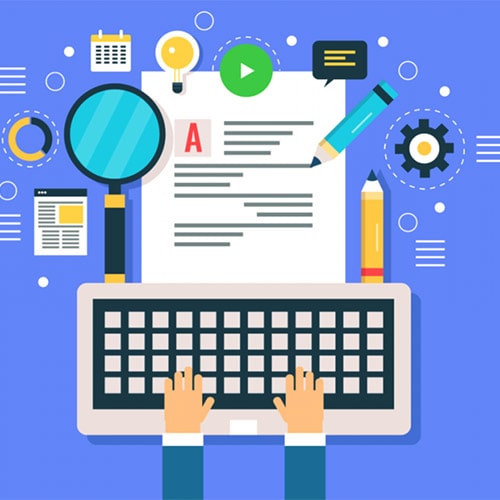Project Material on; Availability and utilization of assistive technology tools for teaching student with virtual impairment in special education schools of Kano metropolis area
Categories
-
ACCOUNTING PROJECT TOPICS AND MATERIALS47
-
ACCOUNTING EDUCATION PROJECT TOPICS AND MATERIALS6
-
ADULT EDUCATION PROJECT TOPICS AND MATERIALS7
-
ACTUARIAL SCIENCE PROJECT TOPICS AND MATERIALS6
-
AGRICULTURAL EXTENSION PROJECT TOPICS AND MATERIALS49
-
ANATOMY PROJECT TOPICS AND MATERIALS5
-
ARCHITECTURE PROJECT TOPICS AND MATERIALS39
-
AGRICULTURAL SCIENCE PROJECT TOPICS AND MATERIALS48
-
ANIMAL SCIENCE PROJECT TOPICS AND MATERIALS49
-
AFRICAN LANGUAGES PROJECT TOPICS AND MATERIALS7
-
BANKING AND FINANCE PROJECT TOPICS AND MATERIALS49
-
BUSINESS ADMINISTRATION PROJECT TOPICS AND MATERIALS45
-
BUSINESS MANAGEMENT PROJECT TOPICS AND MATERIALS23
-
BUSINESS EDUCATION PROJECT TOPICS AND MATERIALS17
-
BIBLICAL AND THEOLOGY PROJECT TOPICS AND MATERIALS35
-
BIOCHEMISTRY PROJECT TOPICS AND MATERIALS48
-
BIOLOGY PROJECT TOPICS AND MATERIALS59
-
BREWING SCIENCE PROJECT TOPICS AND MATERIALS3
-
BUILDING AND TECHNOLOGY PROJECT TOPICS AND MATERIALS50
-
COMPUTER SCIENCE PROJECT TOPICS AND MATERIALS47
-
CHEMISTRY PROJECT TOPICS AND MATERIALS35
-
COMMERCE PROJECT TOPICS AND MATERIALS25
-
COMPUTER SCIENCE EDUCATION PROJECT TOPICS AND MATERIALS17
-
CURRICULUM STUDIES PROJECT TOPICS AND MATERIALS3
-
CIVIL ENGINEERING PROJECT TOPICS AND MATERIALS49
-
CHEMICAL ENGINEERING PROJECT TOPICS AND MATERIALS50
-
ECONOMICS PROJECT TOPICS AND MATERIALS50
-
EDUCATION PROJECT TOPICS AND MATERIALS49
-
ENGLISH PROJECT TOPICS AND MATERIALS49
-
ELECTRICAL & ELECTRONICS PROJECT TOPICS AND MATERIALS58
-
ENVIRONMENTAL SCIENCE PROJECT TOPICS AND MATERIALS52
-
ESTATE MANAGEMENT PROJECT TOPICS AND MATERIALS52
-
ENTREPRENEURSHIP PROJECT TOPICS AND MATERIALS52
-
FOOD SCIENCE & TECH. PROJECT TOPICS AND MATERIALS52
-
FINE & APPLIED ARTS PROJECT TOPICS AND MATERIALS43
-
FISHERY & AQUACULTURE PROJECT TOPICS AND MATERIALS50
-
FORESTRY & WILDLIFE PROJECT TOPICS AND MATERIALS5
-
GUIDANCE AND COUNSELING PROJECT TOPICS AND MATERIALS50
-
GEOGRAPHY PROJECT TOPICS AND MATERIALS53
-
GEOLOGY PROJECT TOPICS AND MATERIALS43
-
HUMAN RESOURCE MANAGEMENT PROJECT TOPICS AND MATERIALS53
-
HEALTH & SEX EDUCATION PROJECT TOPICS AND MATERIALS24
-
HOME ECONOMICS PROJECT TOPICS AND MATERIALS49
-
HUMAN KINETICS PROJECT TOPICS AND MATERIALS20
-
INFORMATION TECHNOLOGY PROJECT TOPICS AND MATERIALS33
-
INDUSTRIAL CHEMISTRY PROJECT TOPICS AND MATERIALS31
-
INSURANCE PROJECT TOPICS AND MATERIALS50
-
INTERNATIONAL RELATIONS PROJECT TOPICS AND MATERIALS50
-
ISLAMIC & ARABIC STUDIES PROJECT TOPICS AND MATERIALS4
-
LAW PROJECT TOPICS AND MATERIALS51
-
LIBRARY SCIENCE PROJECT TOPICS AND MATERIALS50
-
MARKETING PROJECT TOPICS AND MATERIALS50
-
MASS COMMUNICATION PROJECT TOPICS AND MATERIALS50
-
MATHEMATICS EDUCATION PROJECT TOPICS AND MATERIALS9
-
MICRO BIOLOGY PROJECT TOPICS AND MATERIALS50
-
MARINE AND TRANSPORT PROJECT TOPICS AND MATERIALS7
-
MECHANICAL ENGINEERING PROJECT TOPICS AND MATERIALS48
-
NURSING PROJECT TOPICS AND MATERIALS50
-
OFFICE TECHNOLOGY PROJECT TOPICS AND MATERIALS51
-
PUBLIC ADMINISTRATION PROJECT TOPICS AND MATERIALS49
-
POLITICAL SCIENCE PROJECT TOPICS AND MATERIALS50
-
PSYCHOLOGY PROJECT TOPICS AND MATERIALS49
-
PHILOSOPHY PROJECT TOPICS AND MATERIALS50
-
PHYSICS PROJECT TOPICS AND MATERIALS30
-
PROJECT MANAGEMENT PROJECT TOPICS AND MATERIALS10
-
PHARMACY PROJECT TOPICS AND MATERIALS38
-
PURCHASING & SUPPLY PROJECT TOPICS AND MATERIALS51
-
PRODUCTION & OPERATIONS MGT. PROJECT TOPICS AND MATERIALS23
-
PETROLEUM ENGINEERING PROJECT TOPICS AND MATERIALS72
-
QUANTITY & SURVEYING PROJECT TOPICS AND MATERIALS45
-
RELIGIOUS & CULTURAL STUDIES PROJECT TOPICS AND MATERIALS17
-
SOCIAL STUDIES PROJECT TOPICS AND MATERIALS12
-
SCIENCE LABOURATORY PROJECT TOPICS AND MATERIALS50
-
SOIL SCIENCE PROJECT TOPICS AND MATERIALS11
-
SOCIOLOGY PROJECT TOPICS AND MATERIALS55
-
STATISTICS PROJECT TOPICS AND MATERIALS51
-
THEATRE ARTS PROJECT TOPICS AND MATERIALS14
-
TOURISM & HOSPITALITY PROJECT TOPICS AND MATERIALS34
-
URBAN & REGIONAL PLANING PROJECT TOPICS AND MATERIALS63
-
VOCATIONAL STUDIES PROJECT TOPICS AND MATERIALS43
-
VETERINARY PROJECT TOPICS AND MATERIALS2
-
ZOOLOGY PROJECT TOPICS AND MATERIALS12
-
EDUCATIONAL TECHNOLOGY PROJECT TOPICS AND MATERIALS28
-
APPLIED SCIENCE PROJECT TOPICS AND MATERIALS2
-
CRIMINOLOGY PROJECT TOPICS AND MATERIALS0
-
COMPUTER ENGINEERING PROJECT TOPICS AND MATERIALS0
-
FRENCH PROJECT TOPICS AND MATERIALS0
-
HISTORY PROJECT TOPICS AND MATERIALS0
-
INDUSTRIAL RELATIONS & PERSONNEL MGT PROJECT TOPICS AND MATERIALS39
-
PHYSIOLOGY PROJECT TOPICS AND MATERIALS0
-
MEDICINE PROJECT TOPICS AND MATERIALS0
-
SECRETARIAL STUDIES PROJECT TOPICS AND MATERIALS0
-
PUBLIC HEALTH PROJECT TOPICS AND MATERIALS0
EDUCATIONAL TECHNOLOGY PROJECT TOPICS AND MATERIALS
Project Material on; Availability and utilization of assistive technology tools for teaching student with virtual impairment in special education schools of Kano metropolis area
Project Material on; Availability and utilization of assistive technology tools for teaching student with virtual impairment in special education schools of Kano metropolis area
1.1
Background to the Study
Education involves the use of information in
changing the behaviour of a less learned person in that area of learning.
Education is a continuous learning process. It is internationally acknowledged
as the core for individual and national development and is therefore, essential
to all –disabled or not. The branch of education that deals with learners with
disabilities or limitations is referred to as special education. These
limitations can range from visual, physical, mental, emotional or hearing
impairments or a combination of two or more of these impairments. Special
education was defined as “a customized educational programme, designed to meet
the unique needs of persons with special needs that the general educational
programme cannot cater for” (National Policy on Education, 2013).Yusuf,
Fakomogbon and Issa (2012)further stated that special education deals with the
education of the disabled who may have visual impairment, hearing impairment,
physical and health impairment, mental retardation, emotionally disturbed,
speech impairment, learning disabled or multiple impairments.
The term ‘Education’ is an exceptionally common and
popular word that is uttered by many people but understood by very few in its
correct point of view. Itproves to be as old as man himself, nevertheless with
time, its significance and objectives have unavoidably undergone certain
changes(National Council of Educational Research and Training, 2014).
Etymologically, the word education was derived from two Latin words ‘Educare’
meaning ‘to raise’ or ‘to bring up’ and ‘Educere’ which means ‘to lead forth’
or ‘to come out’(Manjula, 2014). Education was also derived from another Latin
term “Educatum” which denotes the act of teaching and throws light on the
principles and practice of teaching (Kumar & Ahmad, 2008). While some
people refer to education as formal schooling, others relate it to lifelong
learning. Some others submit that it is the acquisition of knowledge, skills
and attitudes. Some say that education is nothing, but training of people’s
mind in a particular direction to bring about desired changes (Manjula, 2014).
For most people, technology makes things easier; for
people with disabilities, technology makes things possible (Radabaugh,
2014).Assistive technology (AT), being of high importance for learning in
specials schools, overtime, cannot be overestimated in terms of its educational
benefits to learners with disabilities as it has proved to be of help in
increasing, maintaining or improving their functional capabilities. Today’s
technologies have the ability to dramatically change the lives of students with
disabilities, enabling them to access the curriculum, participate in learning
activities alongside their peers, personalize their learning, and achieve their
full potential. An understanding of assistive technologies (AT) and accessing
them will help school personnel make informed decisions when they evaluate
students’ special needs. Better still, this knowledge will help schools develop
educational environments and programs that can meet the needs of all students,
regardless of whether they have disabilities (Massachusetts Department of
Elementary and Secondary Education, 2012).
Assistive Technologies (AT) can be applied as
adaptive technologies for persons with mobility impairments through the use of
wheelchairs, transfer devices(patient lifts), walkers, and so on; visual
impairments through the use of screen readers, Braille and Braille embossers,
desktop video magnifiers, screen magnification software, large-print and
tactile keyboards, navigation assistance, and so on; hearing impairments
through the use of hearing aids, assistive listening devices, amplified
telephone equipment, augmentative and alternative communication, and so on;
cognitive impairments through the use of memory aids, educational software, and
so on(Barrue, 2012).
The CRPD(Convention on the Rights of Persons with
Disabilities, 2006), identifies those with disabilities as people who have
long-term physical, mental, intellectual or sensory impairments which in
interaction with various barriers may hinder their full and effective
participation in society on an equal basis with others. The Nigerians with
Disability Decree of 1993 noted in Section 2(C) that disabled persons are
provided equal and adequate education (Cornell University ILR School, 1993).
The document noted under section 5, subsection 4(2) among others advocated
improvement of facilities and equipment in educational institutions to
facilitate the education of the disabled; establishment of a National Institute
of Special Education, strengthening of cooperation and collaboration among
relevant authorities, organs, institutions to ensure early and coordinated
education of the disabled; and interaction and exchange between disabled
children in special schools and children in ordinary schools, among others
(Yusuf, Fakomogbon & Issa, 2012).
The availability, application and use of assistive
technologies in special schools have raised questions among researchers over
the years. The principal reason for providing assistive technology in school is
to enable students to meet the instructional goals set forth for them. School
personnel should look at tasks that each student needs to accomplish, the difficulties
the student is having, and the ways that various devices might help the student
better accomplish those tasks (Massachusetts Department of Elementary and
Secondary Education, 2012). Assistive technologies can exist as hardware and
software devices that can help people with disabilities and special needs to
overcome the challenges of learning and information that they might be facing.
Although, there are a few available assistive technologies today, some people,
due to gender and other reasons, are finding it difficult to integrate.
Children with disabilities face extreme disparities
and daunting challenges to the enjoyment of academic, social, and community
participation in low and middle-income countries (World Health Organization,
WHO, 2011). They are subjected to additional discrimination and social
exclusion based on age, gender, social status, language, ethnicity, religion,
living in conflict zones and other factors. Girls with disabilities are
particularly at risk of discrimination and abuse (WHO & UNICEF, 2012).
Gender differences concerning the use of technology
and the attitude towards technology is another broad research field. Whereas
gender is widely researched in the context of information technologies, it has
not been subject studies on acceptance of medical (assistive) technologies, yet
(Wilkowska, Gaul & Ziefle, 2010). Several studies revealed that men have a
greater interest and a more positive attitude regarding computer usage, due to
a higher self-esteem and greater experience with information technologies
(Schumacher & Morahan-Martin, 2001; Meelissen & Drent, 2008). In the
context of technology adoption in workplace studies showed that there are
different aspects that influence the decision to adopt new computer
technologies of men and women. For men, it is mainly their attitude towards
using a new technology whereas women are more influenced by subjective norm and
behavioural control (Morris, Venkatesh & Ackerman, 2005).
The extent to which advanced academic degrees,
majoring in the field of teaching, years of experience and intensive
participation in professional development activities, all assumed to be
cardinal teacher qualifications, indeed have a positive impact on student
learning. Because of psychometric difficulties in assessing teachers by their
normative attributes – the logical, psychological, and especially the ethical,
which tend to differ across cultures, the tendency to evaluate teacher
qualities based on student performance is further emphasized. With the
increased demands for accountability in line with performance standards and
with the growing demand for evidence-based policy making, students achievements
are considered an accurate measure of effectiveness and has become a basis for
value-added teacher assessment systems (Zuzovsky, 2007).
In tracing teacher education development and reforms
in terms of the major questions that have driven the field, Cochran-Smith
(2001) argues that it is currently "the outcome" question that
motivates teacher education research and policymaking. She stated three ways in
which outcomes of teacher education are constructed: the long-term impact
outcomes, teacher test scores and professional performance. Long-term
outcomesrefer to the relationship between teacher qualifications ranging from
their test scores on licensure examination; level of degrees, years of
experience, preparation in subject matter and in pedagogy; certification in
their expertise area, and their ongoing professional development and student
learning (Zuzovsky, 2007). Special education teachers, especially in middle and
high school, should be exposed to technological tools that can help students to
bypass their academic weaknesses (Mull & Sitlington, 2003). Teachers will
help students by training them to use portable and cheap tools that, in most
cases, could make students live and behave more independently when they leave
high school, which will increase their chances of maximizing their degree of
achievement and independence, though it will still be behind their peers without
disabilities (Blackorby & Wagner, 1996; Alnahdi, 2014).
Most studies that examined the availability of
assistive technologies for special education were conducted outside Nigeria; in
fact, very few have examined the application of ICT for students with
disability within the African context (Farrell & Shafika, 2007; Yusuf &
Fakomogbon, 2008) as cited by (Yusuf, Fakomogbon & Issa, 2012). Hence, this
study may provide helpful tips on the prospect of technology, its integration,
approval and usage for teaching and learning in Nigeria as it will investigate
the availability and utilization of assistive technologies for special
education in Kano metropolis area, Kano state, Nigeria.
1.2
Statement of the Problem
In general education classrooms, teachers work with
children who have different intellectual, physical, sensory, or emotional
abilities (Heward, 2009). There are those learners who exhibit low intelligence
or are short sightedness and cannot see the board clearly or are tired and
absent minded which gives the teacher the challenge of carrying slow learners
along as well as those with clearer visibility and attracting the attention of
other absent-minded learners. Learners with disabilities face many challenges
towards attending school and partaking in formal education. Without assistive
technology (AT) and accessible environments, children with disabilities may be
unable to go from home to school, see what is written on the blackboard, hear
and understand the teacher, read the textbooks, use sanitation facilities,
participate in sports and recreation, and interact with classmates(WHO &
UNICEF, 2015).
Special education in Nigeria is currently faced with
a lot of problems ranging from low funding of special schools, unavailability
of adequate assistive technologies in special schools and ignorance in
operation of assistive technological gadgets. Nigeria has limited facilities
for the education of disabled children and that many children apparently lack
access to education and learning aids and the available equipment are extremely
inadequate (Christopher, 2013). Itis a thing of necessity to consider our
special schools to see ifthese assistive technologies are available and are
being properly utilized.
1.3 Objectives of the Study
The main purpose of this study is to investigate the
availability and utilization of assistive technologies (AT) for special
education in Kano metropolis area, Kano State. Specifically, this study will:
1.
To determine the significant effects of
the availability and utilization of assistive technology tools for teaching
student in special education schools of Kano metropolis area
2.
1.7
Significant of the Study
This study would be significant to special
students/learners with disabilities, teachers, educational administrators, education
policy formulators, educational technologists, assistive technologists, and
administrators of special schools as well as future researchers in the field of
special education and assistive technology. This study would assist the
disabled learners by considering those assistive technologies (AT) that are
available in their schools and check the need for more sophisticated assistive
technological gadgets to enhance their formal learning and development.
Teachers and educational administrators and administrators
of special schools would be enlightened on the plights that disabled learners
go through and work on improving their efficiency and involvement in the
classroom as well as during extra-curricular activities and assist in the
elimination of exclusion of the disabled and the stigma that they face. The
state of assistive technologies (AT) in Kano metropolis area would be exposed
to Educational policy formulators so that they will have more urgent bases to
make more effective policies to assist the disabled in an environment that
focuses on the more privileged.
This study could give insights to educational
technologists and assistive technologists on how they can assist with the
production of more accessible technologies which includes improvised technologies
made of very available raw materials which will not be stratified for the
well-to-do handicapped but available and affordable for the use of all kinds of
disabled persons especially within Kano metropolis area. This study will
provide information to Professional Associations and Textbook writers to assist
them with dealings relating to assistive technology and special education. The
study will also give insights to Future researchers in the field of assistive
technology and special education which will assist and guide them through their
much-needed researches for the good of all disabled individuals who wish to
overlook their physical shortcomings and disabilities and enrol in a special
school for educational growth.
1.8
Definition of Terms
The following terms and variables for this study are
clarified operationally as follows:
Assistive
Technology (AT): are devices that can be used to make up
for the lack of certain abilities. For example, hearing aids for hearing
impaired people; Braille for visually impaired people and so on.
Special
School: is a place for learning meant training students
with special educational needs
Special
Education: is a branch of education for formal learning of
students with special educational needs.
Adaptive technology: is any hardware and software
that assist persons with disabilities to overcome their physical shortcomings.
Availability:
is the presence of any assistive technology device.
Utilization:
is the measure of use of assistive devices.
Disability:
is the state of being handicapped or having impairment.
Impairment:
is the disability, incompetence or ineffectiveness of one or more parts of a
person’s composition.
Experienced
Teacher: is any teacher who has been in the teaching service
over a long period of time.
Less-Experienced
Teacher: is any teacher who has barely just started their
job with the teaching service.
Qualified
Teacher: is any teacher who has acquired at least a
certification to enable them to teach and have been inducted into the teaching
service.
Less-Qualified
Teacher: is any teacher who do not have any certification or
induction program that allows them to teach.





